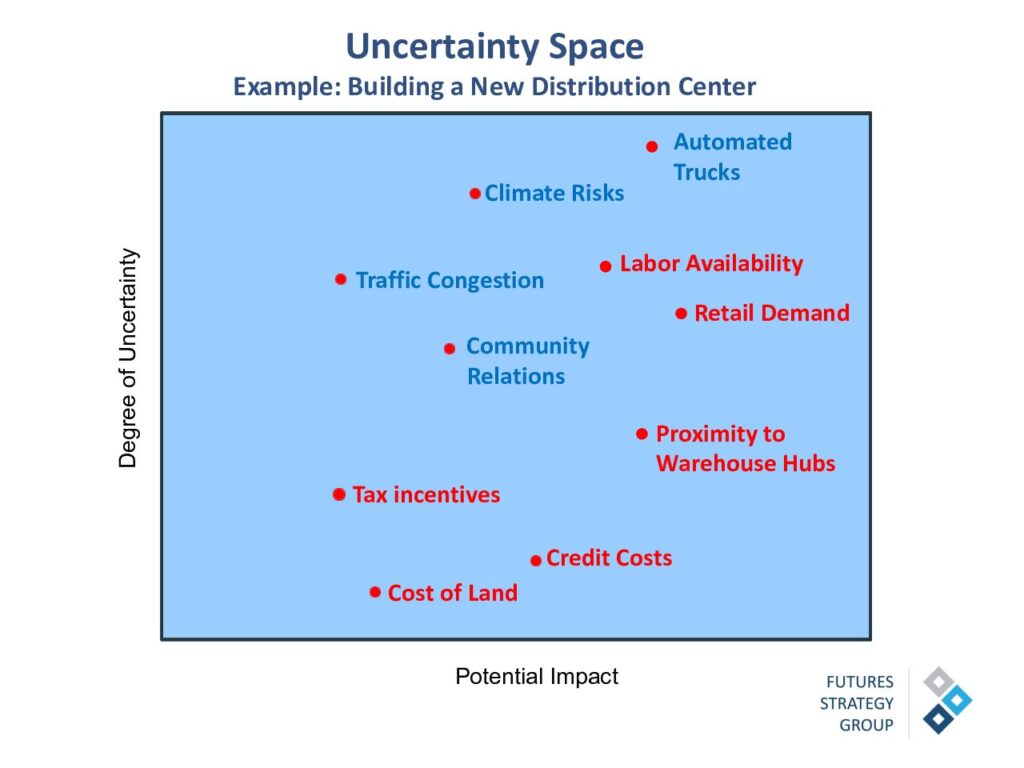Every age is acquainted with the mind-clouding anxiety that can come with volatility. In the spring of 2022 volatility seems especially acute. Ukraine, inflation, Covid, our brutal politics, the threat of economic recession—this moment is giving us a visceral experience of what scenario planners call “the uncertainty space.”
Here is the thing to know about the uncertainty space: for better and/or worse the period it describes will eventually end. But while moving through it smart people may become paralyzed with indecision for which they may later pay a price. Just as bad, they may fail to explore unfamiliar risks coming from outside the traditional operating environment.
When confronted with severe uncertainty the reflex for many of us is to wait it out. We tell ourselves we are prudent. Meaningful choices—the location of a new facility, say, or a strategic acquisition—often cannot wait until the horizon clears. That only causes problems later, not the least of which is missed chances.
If a decision has a short fuse, of course, we do the best we can with the information we have. But if a decision has a longer tail into an uncertain future we would be wise to think rigorously about the uncertainty space, a term that encompasses all the important but uncertain forces affecting the factors in our choices, whether these choices are strategic or tactical.
Imagine you need to decide—and soon—about siting a new distribution center. The standard business considerations go into your decision: cost, ease of access, labor availability, government regulations and so forth. Some of these will be known; others will be less certain. Make a list of both but begin with what you know.
Cataloguing the Uncertainties
With the less certain factors, begin by naming them aloud and as specifically as you can. This will give you the range of uncertainty surrounding your investment. Some uncertainties may be unambiguously good things for you, such as government investment in the highway infrastructure. Others might be contextual such as local employment levels, the advent of autonomous trucks, the staying power of the work-from-home phenomenon, interest rates on the money you borrow and a great many other forces that might—at first—seem extraneous to your operating environment.
By thinking expansively you will realize that many exogenous factors—forces you do not control—often have surprising bearing on your decision.
Visualizing the Uncertainty Space
You might also consider plotting factors on a simple XY graph. The x axis represents the potential impact of a factor on your decision. The y axis depicts degree of uncertainty around that factor’s direction.
Here is a notional representation of this below using a simplified version of the distribution-center case:

The red plots are considerations that would go into any business plan. The blue ones come from our uncertainty list. What is interesting is how many of the blue plots are both highly uncertain and impactful. What does that tell us? For one, that one or more of the more highly uncertain factors could end up being highly consequential to the success of a planned investment.
You can see, for instance, that climate risks may have an extraordinary impact on the choice you make in ways that might surprise you. Not just floods and wildfires but infrastructure degradation, traffic delays, higher insurance premiums and so on. Naming the uncertainty makes clear that it requires further research and risk analysis before any decisions are made.
A Group Activity
Mapping the uncertainty space—like most foresight activities—is an exercise in judgment. Ideally, it should be a group activity that taps into the diverse backgrounds, experiences and perspectives of team members.
The value of mapping your uncertainty is not that it will magically reveal all you need to factor into important decisions. What we call “rigorous imagination” is essential. Never forget that there are no hard numbers when it comes to the future.
Inevitably things will happen that even the most imaginative foresight techniques will miss. But by deliberately thinking about external uncertainties not directly tied to conventional business factors, an organization reduces the odds of missing not just the obvious big things but the subtler things, the things that, in combination with other factors, can substantively change operating conditions for good and bad. Along the way the organization is directly confronting the costly inertia that affects even high-performing teams during times of great turbulence and uncertainty.
When it comes to strategic choices, mapping the uncertainty space is more challenging and more consequential. The stakes are higher. The future fog is denser. This is an argument for taking it to the next level with scenario planning, which provides a framework for capturing critical drivers of future change and methodically exploring their implications for strategy and operations. There is no better tool for managing the complexity and uncertainty that surround our emerging futures.
Of that we are certain.
